Video: Easter overshadowed by war for Christians in Palestine
[unable to retrieve full-text content] Palestinian Christians in the occupied West Bank and Gaza find little joy beset by war and conflict.
Russia-Ukraine war: List of key events, day 1,148
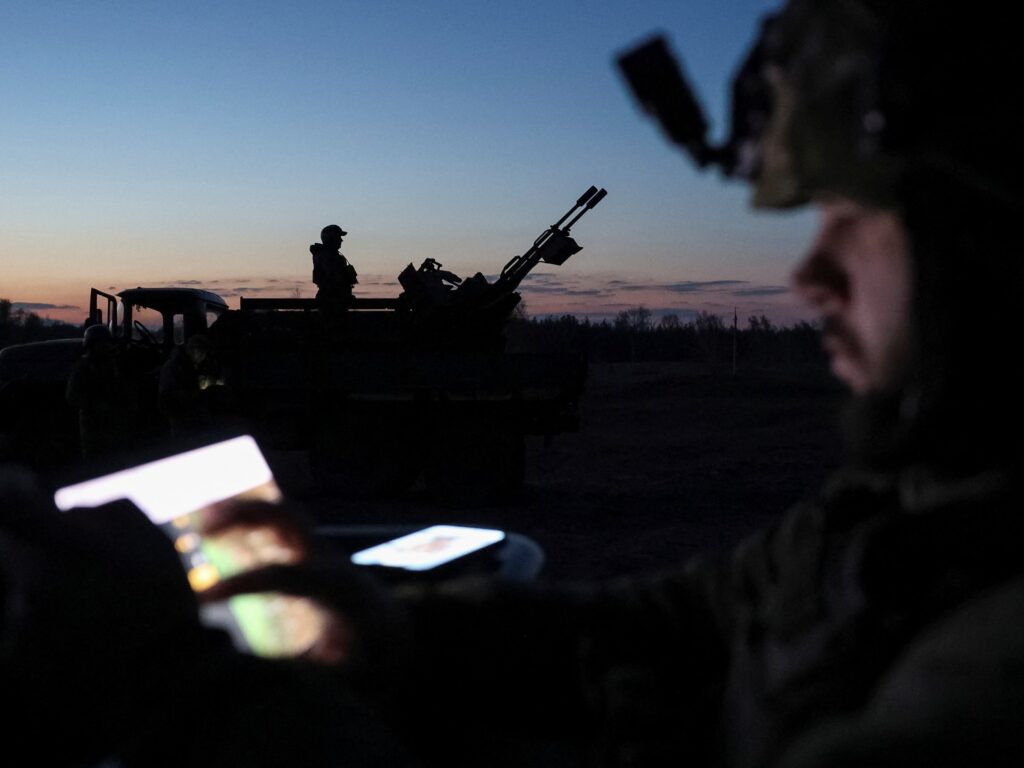
These are the key events on day 1,148 of Russia’s war on Ukraine. Here is where things stand on Thursday, 17 April: Fighting A Russian drone attack on the Black Sea port city of Odesa overnight injured three people, sparked fires and damaged homes and civilian infrastructure, regional governor Oleh Kiper said. Russia’s Ministry of Defence said its units destroyed 26 Ukrainian drones overnight. Nine of the drones were shot down over the southern Voronezh region, while eight were taken down over the border region of Belgorod. The remaining drones were downed over the Kursk, Lipetsk and Moscow regions, as well as over the Russian-annexed Crimean peninsula, the ministry said. The Defence Ministry also said Russia has taken control of Kalynove village in Ukraine’s eastern Donetsk region. Moscow’s military further reported that it repelled seven Ukrainian drones over Russia’s Ivanovo region, the location of one of two Russian missile units that Kyiv accuses of launching a deadly attack on the city of Sumy which caused dozens of casualties last weekend. Kyiv’s air force said Russia launched almost 100 drones in overnight attacks on Ukraine, of which 57 were shot down and another 34 failed to reach their targets, likely due to electronic warfare measures. Advertisement Russian glide bombs and artillery struck the city of Kherson in southern Ukraine on Wednesday, killing one person and wounding nine others, in what Ukrainian officials described as a timed “double-tap strike”. The region’s head, Oleksandr Prokudin, said it was a “deliberate tactic by Russia” to prevent rescuing victims and to harm medics, rescuers and police officers who rushed to the scene of the first attack only to then be caught in the second strike. A Russian mass drone attack killed two people and injured 16 in the southeastern Ukrainian city of Dnipro, regional governor Serhiy Lysak said. Five of the injured were hospitalised. The Security Service of Ukraine (SBU) said it detained nine people, including five teenagers, with more than 30kg (66 pounds) of explosives on suspicion of preparing sabotage attacks on behalf of Russia. Attacks on energy facilities Russia’s Defence Ministry said Ukraine carried out six attacks on Kremlin energy infrastructure despite a mutually agreed 30-day moratorium on energy strikes. Ukraine’s Ministry of Foreign Affairs spokesperson, Heorhii Tykhyi, told a news briefing that Russia carried out more than 30 attacks on its energy infrastructure since the two sides agreed in March to pause strikes on such targets. Kremlin spokesperson Dmitry Peskov said Russia would announce when the US-brokered moratorium on energy strikes would end. Politics and diplomacy United States President Donald Trump’s administration has reduced its estimate for the cost of US assistance provided to Kyiv since the start of Russia’s invasion to about $100bn from $300bn, Bloomberg news reports, citing people familiar with the matter. The US and Ukraine have made “substantial progress” in their talks on a minerals deal and will soon sign a memorandum, which would give Washington access to Ukraine’s rare earth deposits, Kyiv’s first deputy prime minister Yulia Svyrydenko said. Advertisement Kyiv’s parliament voted to extend martial law in Ukraine until 6 August. The decision was supported by an overwhelming 357 deputies, while one politician voted against the bill. Russian President Vladimir Putin and Qatar’s Emir Sheikh Tamim bin Hamad Al Thani will discuss Ukraine among other issues during the emir’s visit to Moscow on Thursday, Kremlin spokesman Peskov said. The former governor of Russia’s Kursk region, Alexei Smirnov, was detained on Wednesday on suspicion of fraud, Russian state news agency TASS reported. Adblock test (Why?)
Trump touts ‘progress’ in Japan trade talks, as uncertainty roils stocks
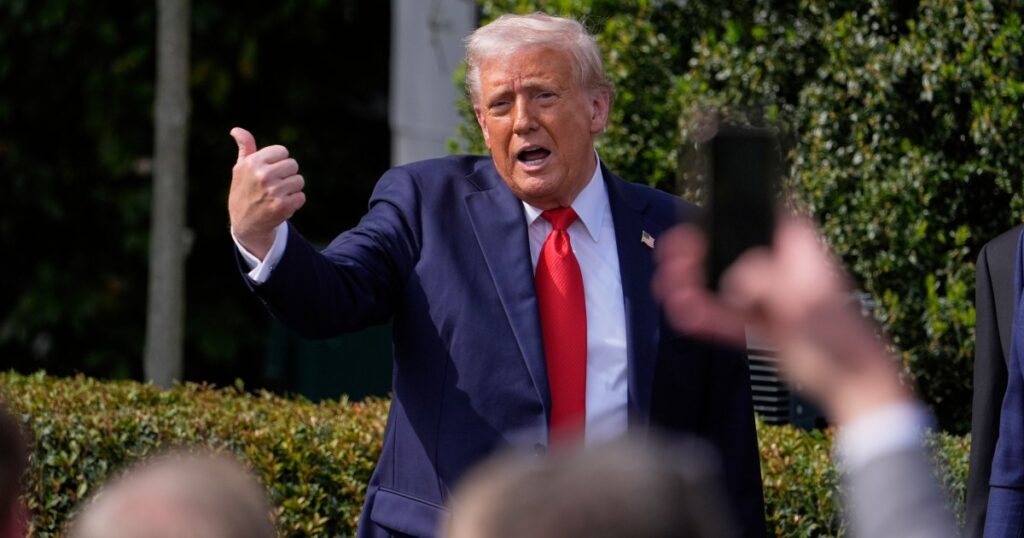
Wall Street closes sharply lower as US Federal Reserve chair warns tariffs could lead to slower growth, higher inflation. United States President Donald Trump has touted “big progress” in trade talks with Japan after making an unexpected intervention in the negotiations, as uncertainty caused by his sweeping tariffs continues to roil stock markets. Trump made his comments on Wednesday after making the surprise decision to sit in on negotiations between his administration and Japanese officials in Washington, DC. “A Great Honor to have just met with the Japanese Delegation on Trade. Big Progress!” Trump wrote on Truth Social after the talks, which included US Treasury Secretary Scott Bessent, US Commerce Secretary Howard Lutnick and Economic Revitalization Minister Ryosei Akazawa. Akazawa said after the meeting that Trump wanted to reach a deal before the end of his 90-day pause on his “reciprocal” tariffs, with the Japanese hoping to see the agreement sealed “as soon as possible.” Japanese Prime Minister Shigeru Ishiba said the negotiations would not be easy, but the initial rounds of talks had “created a foundation for the next steps”. Advertisement Like dozens of other US trade partners, Japan has been hit with a 10 percent baseline tariff in addition to duties of 25 percent on cars, steel and aluminium, which rank among the East Asian country’s top exports. Japan, a top US security ally and its fourth-largest trade partner, is also facing a targeted 24 percent “reciprocal” tariff under Trump’s “liberation day” trade measures, nearly all of which have been paused until July 9. “Japan’s industry is so closely integrated in the US economy that everyone is very concerned about the trade talks,” Martin Schulz, chief policy economist at Fujitsu in Tokyo, told Al Jazeera. “Although there cannot be winners in a trade war, we are also quite optimistic that agreeable results can be achieved. Japan is the largest investor in the US and interested in investing more.” “If both economies can be kept on a growth track, higher imports from the US become possible,” Schulz added. The US-Japanese talks came as Wall Street racked up further heavy losses amid continuing uncertainty over Trump’s trade salvoes. The benchmark S&P 500 closed 2.24 percent lower on Wednesday, while the tech-heavy Nasdaq Composite fell 3.07 percent. The losses followed a warning by US Federal Reserve Chair Jerome Powell that Trump’s steep tariffs could leave the US economy grappling with weak growth, rising unemployment and higher inflation all at once. “We may find ourselves in the challenging scenario in which our dual-mandate goals are in tension,” Powell said in a speech to the Economic Club of Chicago on Wednesday, referring to the US central bank’s twin goals of maximum employment and stable prices. Advertisement “If that were to occur, we would consider how far the economy is from each goal, and the potentially different time horizons over which those respective gaps would be anticipated to close.” US stocks have been on a rollercoaster ride since Trump’s inauguration in January, alternating between sharp dips and big jumps amid his back-and-forth tariff announcements. Financial markets and businesses have been on tenterhooks waiting for signs that the US president is open to watering down or scrapping many of his tariffs in exchange for concessions from US trading partners. Trump administration officials have said that more than 75 countries have reached out to begin negotiations on trade. After the latest losses on Wall Street, the S&P 500 and Nasdaq are down about 10 percent and 15 percent, respectively, since the start of the year. Asian stock markets got off to a better start on Thursday, with Japan’s benchmark Nikkei 225, South Korea’s KOSPI and Hong Kong’s Hang Seng Index each rising more than 0.5 percent in early trading. Adblock test (Why?)
As Trump threatens tariffs, Vietnam scrambles to avert economic disaster
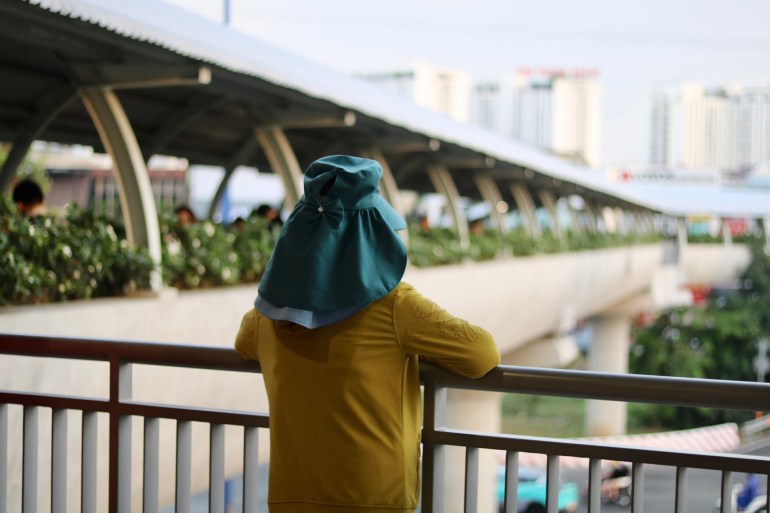
Ho Chi Minh City, Vietnam – Kieu Quoc Thanh, the CEO of cashew export business SVC Group, says that everyone in his industry has been “feeling crazy” for the past two weeks. Since United States President Donald Trump announced his since-paused “reciprocal” tariffs on April 2, Thanh has witnessed mass confusion among Vietnamese exporters. Many businesses reliant on the US market are checking online hourly for updates on the tariffs, Thanh says, while he has a shipping container full of cashews bound for the US market currently sitting in limbo. Since Trump announced a 90-day pause on Vietnam’s 46 percent tariff and duties on dozens of other countries, the US has imposed a baseline 10 percent levy on imports from all countries, including Vietnam. But Thanh’s customers in the US and customs officers alike are uncertain how much to tax his products, he says. “No one knows what’s happening,” Thanh told Al Jazeera at his Ho Chi Minh City office last week. A man stands outside Phuc Long Port in Ho Chi Minh City, Vietnam, on April 10, 2025 [Govi Snell/Al Jazeera] While businesses such as Thanh’s navigate the disruption, Hanoi and Washington are in discussions about a trade deal after agreeing to begin negotiations on April 10. Advertisement For Vietnam, one of the world’s most export-reliant economies, the stakes could scarcely be higher. The US is the Southeast Asian country’s biggest export market, with shipments to it alone last year accounting for 30 percent of gross domestic product (GDP). While Trump’s tariff pause led to some hope in Vietnam, the country is on tenterhooks about what might happen next, said Tyler Manh Dung Nguyen, chief market strategist at equity firm Ho Chi Minh City Securities Corporation. “We are having a period of extreme uncertainty, not only for the financial market, but also for businesses,” Nguyen told Al Jazeera. “It’s like a reality show,” Nguyen added. “Everything changes every day.” Trump’s trade salvoes have drawn sharp contrast with the decades-long process of warming relations between Washington and Hanoi, culminating in the former enemies upgrading their ties to a “Comprehensive Strategic Partnership” in 2023. For Eddie Thai, a Vietnamese American who co-founded the Ho Chi Minh City-based venture capital firm Ascend Vietnam Ventures, it has been disheartening to see relations come under strain, particularly ahead of the upcoming 50th anniversary of the end of the Vietnam War on April 30. “I don’t think it has thrown us back 50 years, I wouldn’t say that far, but it is burning a lot of goodwill that a lot of people on both sides of the ocean have been trying to build since the 90s,” Thai told Al Jazeera, calling Trump’s dealing with Vietnam destructive and personally “disappointing as an American”. Chinese President Xi Jinping waves as he boards his plane at Noi Bai International Airport in Hanoi on April 15, 2025 [Athit Perawongmetha/ Pool via AFP] With the US and Vietnam looking towards a trade deal, China, Hanoi’s biggest source of imports and its second-largest export destination, has loomed large over the negotiations. Advertisement On Monday, Chinese President Xi Jinping visited Hanoi as part of a five-day tour of Southeast Asia, a trip widely seen as an effort to cast China as a more reliable trading partner for the region than the US. Upon his arrival, Xi was greeted at the airport by Vietnamese President Luong Cuong, and later received a 21-gun salute at Hanoi’s Presidential Palace. Reacting to the warm reception for the Chinese leader, Trump suggested the countries would use their talks to scheme against the US. “That’s a lovely meeting. Meeting like, trying to figure out, ‘How do we screw the United States of America?’” Trump told reporters at the White House. According to Chinese state news outlet Xinhua, Xi urged Vietnam to resist “unilateral bullying” and stated that “China’s mega market is always open to Vietnam”. During Xi’s visit, the countries signed 45 agreements, Chinese and Vietnamese media reported, without providing details of the deals. With the US and China slapping each other’s goods with tariffs exceeding 100 percent, Vietnam has become the “diplomatic guy in the middle,” said Nguyen, the strategist at Ho Chi Minh City Securities Corporation. “[Hanoi] always tries to be neutral in every situation,” Nguyen said. “We do not side with one country to fight another country.” US trade deficit Trump’s tariffs have also raised the ire of foreign businesses based in Vietnam. It would be an impossible task for Vietnam to erase its trade deficit with the US – the third-highest in 2024 at $123.5bn – given the differences between the two economies, said Bruno Jaspaert, general director of DEEP C Industrial Zones in the northern port town of Haiphong. Advertisement “Any country like Vietnam, in reality, has no leverage against the States,” Jaspaert, who is also head of EuroCham Vietnam, told Al Jazeera. “That stupid formula of theirs can never ever be balanced because it will take decades before Vietnam can buy enough,” Jaspaert said, referring to the controversial calculations used by the Trump administration to come up with its “reciprocal” tariff rates. Facing the threat of a huge economic blow, Hanoi has put considerable effort into getting into the good graces of the Trump administration. The government has pledged to buy more Boeing planes and liquefied natural gas, and opened talks on purchasing C-130 cargo planes from Lockheed Martin. Last month, officials agreed to allow Elon Musk’s Starlink satellite internet service to operate in the country on a trial basis. Vietnam has also signed deals with the Trump Organization. Shortly before Trump’s re-election, his holding company agreed to invest $1.5bn in a golf course and hotel project in Communist Party chief To Lam’s home province of Hung Yen. Commuters sit in traffic in Ho Chi Minh City, Vietnam [Govi Snell/Al Jazeera] “I believe that the leadership in Hanoi – they have done a lot to secure a more lenient approach,” Nguyen Khac Giang, visiting fellow at Singapore’s ISEAS-Yusof Ishak Institute, told
US envoy says fighting in Gaza would ‘end immediately’ if captives released
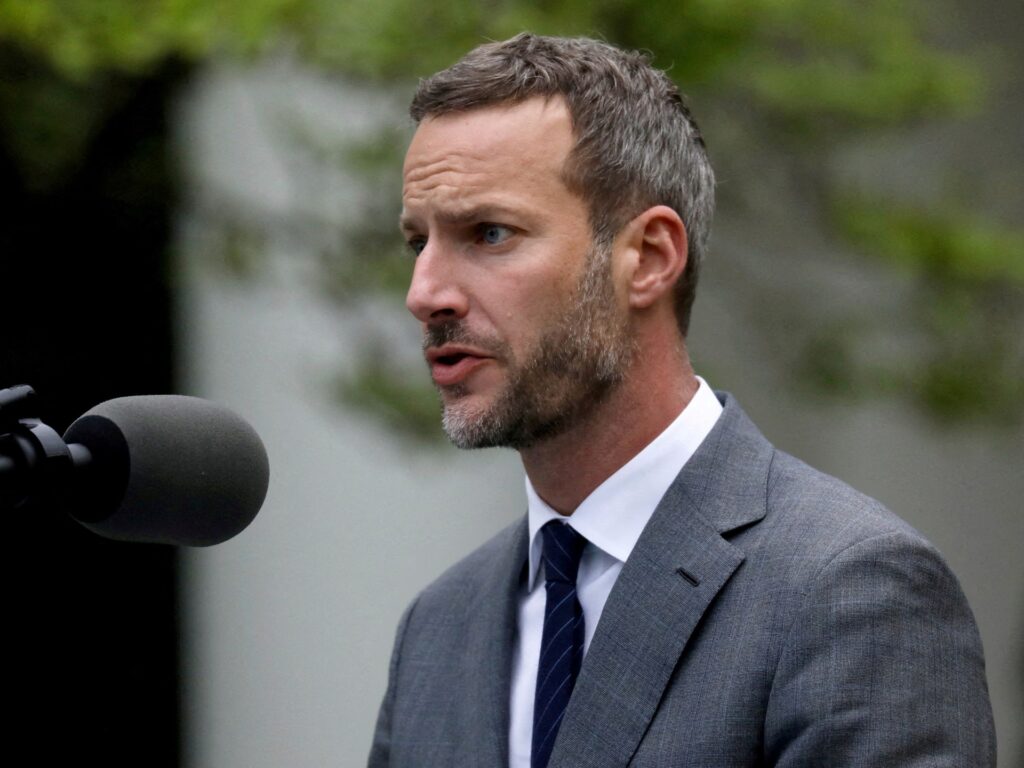
Adam Boehler tells Al Jazeera ‘nothing goes forward’ on ceasefire deal until release, as Israel’s assault continues. Washington, DC – Israeli attacks on Gaza will end if Hamas releases all remaining captives, US President Donald Trump’s top hostage envoy said in an interview with Al Jazeera. “I can tell you that the fighting would end immediately, immediately if hostages are released,” said Adam Boehler, US special envoy for hostage response. “The day that those hostages are released, the fighting will end.” Boehler’s comments on Wednesday came as the death toll from Israel’s offensive in Gaza reached 51,025, with at least 1,652 Palestinians killed since Israel’s attacks resumed after an earlier ceasefire brokered by Trump’s administration ended in March. Despite Israel’s ongoing assault on the enclave, Boehler said the ball was in Hamas’s court. “They can reach out any time,” he said from the White House lawn. “Hamas can end this.” Boehler added that Trump has been clear that “nothing goes forward until all hostages are released”. “Step one is all hostages released,” Boehler said. “Step two is, let’s figure out this day after.” Advertisement He did not elaborate on what that “day after” would look like, only referring briefly to Trump’s suggestion of mass displacing Palestinians from Gaza to neighbouring countries. Hamas has said it will only release more captives if a new agreement to end the fighting is reached first. Such an agreement would need to include guarantees that have so far proven non-starters, including a full withdrawal of Israeli forces from Gaza. Under the previous six-week ceasefire agreement, Hamas released a total of 33 captives held in Gaza in exchange for an increase in humanitarian aid into the enclave and the release of Palestinian prisoners held by Israel. A second phase, agreed to in principle, was meant to see the release of all remaining captives held in Gaza in exchange for a permanent end to fighting. A third phase was meant to see the release of all the bodies of captives and the implementation of a reconstruction plan. But negotiations broke down following the completion of the first phase of the agreement, with Israel immediately renewing attacks. Beyond those killed, the United Nations has said at least 500,000 Palestinians have been newly displaced in the latest round of fighting. Earlier this week, Israeli Defence Minister Israel Katz said the military had completed creating a “security zone” between the southern cities of Rafah and Khan Younis. He added that the Israeli military would “vigorously” expand its operation in Gaza. Israel has estimated that 24 living captives remain in Gaza, all believed to be male soldiers. The bodies of 35 other captives are also believed to still be in the Palestinian enclave. Advertisement Edan Alexander Boehler, who held direct talks with Hamas officials in March, spoke to Al Jazeera after Hamas rejected a new Israeli ceasefire proposal calling for the group to fully disarm the day before. Hamas also claimed on Tuesday that it had lost contact with the group holding Israeli-American captive Edan Alexander after “direct Israeli bombardment” targeted the area where he was being held. Boehler dismissed the claim, saying he was certain Alexander was in a safe place and that Hamas would be “stupid” to harm him. If anything were to happen to Alexander, it’s “not going to be pretty”, he added, without elaborating. Adblock test (Why?)
Fifty years after fall of Phnom Penh, history weighs on Cambodian politics

Fifty years after the fall of Phnom Penh to the Khmer Rouge rebel army, the events of April 17, 1975 continue to cast a long shadow over Cambodia and its political system. Emerging from the bloodshed and chaos of the spreading war in neighbouring Vietnam, Pol Pot’s radical peasant movement rose up and defeated the United States-backed regime of General Lon Nol. The war culminated five decades ago on Thursday, with Pol Pot’s forces sweeping into Cambodia’s capital and ordering the city’s more than two million people into the countryside with little more than the belongings they could carry. With Cambodia’s urban centres abandoned, the Khmer Rouge embarked on rebuilding the country from “Year Zero”, transforming it into an agrarian, classless society. In less than four years under Pol Pot’s rule, between 1.5 and three million people were dead. They would also almost wipe out Cambodia’s rich cultural history and religion. Many Cambodians were brutally killed in the Khmer Rouge’s “killing fields”, but far more died of starvation, disease and exhaustion labouring on collective farms to build the Communist regime’s rural utopia. Advertisement In late December 1978, Vietnam invaded alongside Cambodian defectors, toppling the Khmer Rouge from power on January 7, 1979. It is from this point onwards that popular knowledge of Cambodia’s contemporary tragic history typically ends, picking up in the mid-2000s with the start of the United Nations-backed war crimes tribunal in Phnom Penh, where former regime leaders were put on trial. For many Cambodians, however, rather than being relegated to history books, the 1975 fall of Phnom Penh and the toppling of the Khmer Rouge in 1979 remain alive and well, embedded in the Cambodian political system. That tumultuous Khmer Rouge period is still used to justify the long-running rule of the Cambodian People’s Party (CPP) under varying forms since 1979, and the personal rule of CPP leader Hun Sen and his family since 1985, according to analysts. It was the now ageing senior leadership of the CPP who joined with Vietnamese forces to oust Pol Pot in 1979. While memories of those times are fading, the CPP’s grip on power is as firm as ever in the decades since the late 1970s. ‘The making of a political system’ The ruling CPP see “themselves as the saviour and the guardian of the country”, said Aun Chhengpor, a policy researcher at the Future Forum think tank in Phnom Penh. “It explains the making of a political system as it is today,” he said, noting that the CPP has long done what it required to “ensure that they are still there at the helm … at any cost”. Most Cambodians have now accepted a system where peace and stability matter above all else. Advertisement “There seems to be an unwritten social contract between the ruling establishment and the population that, as long as the CPP provides relative peace and a stable economy, the population will leave governance and politics to the CPP,” Aun Chhengpor said. “The bigger picture is how the CPP perceives itself and its historic role in modern Cambodia. It’s not that different from how the palace-military establishment in Thailand or the Communist Party in Vietnam see their roles in their respective countries,” he said. A Cambodian student looks at a poster of former Khmer Rouge leaders during an educational outreach programme [File: Tang Chhin Sothy/AFP] The CPP headed a Vietnamese-backed regime for a decade, from 1979 to 1989, bringing relative order back to Cambodia after the Khmer Rouge, even as fighting persisted in many parts of the country as Pol Pot’s fighters tried to reassert control. With support dwindling from the Soviet Union in the last days of the Cold War and an economically and militarily exhausted Vietnam withdrawing from Cambodia, Hun Sen, by then the leader of the country, agreed to hold elections as part of a settlement to end his country’s civil war. From 1991 to 1993, Cambodia was administered by the UN Transitional Authority in Cambodia (UNTAC). The Cambodian monarchy was formally re-established, and elections were held for the first time in decades in 1993. The last Khmer Rouge soldiers surrendered in 1999, symbolically closing a chapter on one of the 20th century’s bloodiest conflicts. Advertisement Despite a bumpy road forward, there were initial hopes for Cambodian democracy. The royalist National United Front for an Independent, Neutral, Peaceful and Cooperative Cambodia Party – better known by its acronym FUNCINPEC – won the UN-administered elections in 1993. Faced with defeat, the CPP refused to cede power. The late King Norodom Sihanouk stepped in to broker an agreement between both sides that preserved the hard-won peace and made the election a relative success. The international community breathed a sigh of relief as the UNTAC mission in Cambodia had been the largest and costliest at that time for the world body, and UN member states were desperate to declare their investment in nation rebuilding a success. Ruling jointly under a power-sharing agreement with CPP and FUNCINPEC co-prime ministers, the unsteady alliance of former enemies held for four years until ending in a swift and bloody coup by Hun Sen in 1997. Mu Sochua, an exiled opposition leader who now heads the nonprofit Khmer Movement for Democracy, told Al Jazeera that the CPP’s resistance to a democratic transfer of power in 1993 continues to reverberate throughout Cambodia today. “The failure of the transfer of power in 1993 and the deal the King made at the time … was a bad deal. And the UN went along because the UN wanted to close shop,” she told Al Jazeera from the US, where she lives in exile after being forced to flee the CPP’s intensifying authoritarianism at home. “The transitional period, the transfer of power … which was the will of the people, never happened,” Mu Sochua said. Advertisement End of warfare does not mean the beginning of peace Following the coup in 1997, the CPP did not come close to losing power again until 2013, when they
Iran confirms next round of nuclear talks with US set for Rome on Saturday
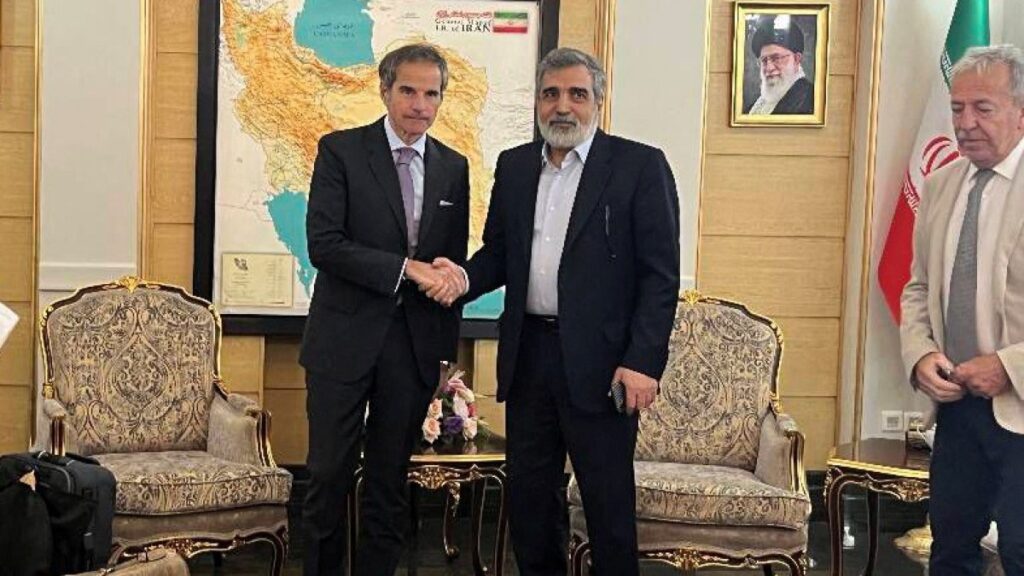
The announcement comes as chief of nuclear watchdog IAEA arrives in Tehran for talks that may revolve around accessibility for inspectors. Iran has confirmed that its next round of nuclear talks with the United States this weekend will be held in Rome after earlier confusion over where the negotiations would be conducted. Wednesday’s announcement on Iranian state television came as Iran’s President Masoud Pezeshkian formally approved the resignation of one of his vice presidents, who had served as Tehran’s key negotiator in its 2015 nuclear deal with world powers. The head of the United Nations nuclear watchdog, Rafael Grossi, also arrived in Tehran on Wednesday for talks that could include negotiations over what access his International Atomic Energy Agency (IAEA) inspectors can get under any proposed deal. The state TV announcement said Oman will again mediate the talks on Saturday in Rome. Oman’s foreign minister served as an interlocutor between the two sides during negotiations last weekend in Muscat, the Omani capital. On Monday, some officials initially identified Rome as hosting the negotiations, only for Iran to insist early on Tuesday that its team would return to Oman. US officials so far have not said publicly where the talks will be held, though US President Donald Trump did call Oman’s Sultan Haitham bin Tariq on Tuesday while the ruler was on a trip to the Netherlands. Advertisement The negotiations come amid soaring tensions between the US and Iran over the latter’s nuclear development. Trump repeatedly has threatened to unleash air strikes targeting Iran’s nuclear programme if a deal isn’t reached. Iranian officials increasingly have warned that they could pursue a nuclear weapon with their stockpile of uranium enriched to near weapons-grade levels. ‘Like a puzzle’ Grossi arrived in Tehran for meetings with Pezeshkian and others, which will likely be held on Thursday. Shortly before his arrival, Grossi warned that Iran was “not far” from possessing a nuclear bomb. “It’s like a puzzle. They have the pieces, and one day they could eventually put them together,” Grossi told French newspaper Le Monde in an interview published on Wednesday. “There’s still a way to go before they get there. But they’re not far off, that has to be acknowledged,” he said. Since the nuclear deal’s collapse in 2018 with Trump’s unilateral withdrawal of the US from the accord, Iran has abandoned all limits on its programme, and enriches uranium to up to 60 percent purity – near weapons-grade levels of 90 percent. Surveillance cameras installed by the IAEA have been disrupted, while Iran has barred some of the Vienna-based agency’s most experienced inspectors. Iranian officials have also increasingly threatened that they could pursue atomic weapons, something that Western countries and the IAEA have been worried about for years. Any possible deal between Iran and the US likely would need to rely on the IAEA’s expertise to ensure Tehran’s compliance. And despite tensions between Iran and the agency, its access has not been entirely revoked. Advertisement ‘Non-negotiable’ Iran’s Foreign Minister Abbas Araghchi on Wednesday warned the US about taking contradictory stances in the talks. His remarks came after comments from US Middle East envoy Steve Witkoff, who this week initially suggested a deal could see Iran go back to 3.67 percent uranium enrichment – like in the 2015 deal reached by the administration of former US President Barack Obama. Witkoff then followed up by saying, “A deal with Iran will only be completed if it is a Trump deal.” “Iran must stop and eliminate its nuclear enrichment and weaponisation program,” Witkoff wrote on the social platform X. “It is imperative for the world that we create a tough, fair deal that will endure, and that is what President Trump has asked me to do.” In response, Araghchi issued a warning to the US. “Enrichment is a real and accepted issue, and we are ready for trust-building about possible concerns,” Araghchi noted. But losing the right to enrich at all “is non-negotiable”, he said. Adblock test (Why?)
Israel says its troops will remain in Gaza, Lebanon and Syria indefinitely

Israel’s defence minister says that Israeli troops will remain in Gaza, Lebanon and Syria indefinitely, as the military tightens its grip on several occupied territories. “Unlike in the past, the [Israeli military] is not evacuating areas that have been cleared and seized,” Israel Katz said in a statement on Wednesday. The army “will remain in the security zones as a buffer between the enemy and [Israeli] communities in any temporary or permanent situation in Gaza – as in Lebanon and Syria”, said the statement. The military said that it had turned 30 percent of Gaza into a “security” buffer zone and struck around 1,200 “terror targets” since resuming its offensive on March 18, following a nearly two-month truce in Gaza with the Palestinian group Hamas. Israeli Prime Minister Benjamin Netanyahu has vowed to annihilate Hamas and return 59 captives being held by armed groups in Gaza, including 24 who Israel believes are alive. Hamas has said it will not agree to release the captives without a complete Israeli withdrawal from Gaza and a lasting ceasefire. Advertisement The Palestinian Islamic Jihad group on Wednesday released a video of captive Rom Braslavski. He appeared to be under duress, said he was covered in sores, and pleaded with Netanyahu to stop the war. The main organisation representing captives’ families accused the Israeli government in a statement of “choosing to seize territory before the hostages”. Israel says it must maintain control of what it calls “security zones” to prevent a repeat of Hamas’s October 7, 2023 attack in which some 1,139 people were killed and 250 others were abducted – includng captives who have already been released by Hamas, and those still being held by the group. Netanyahu also has said that Israel will implement US President Donald Trump’s proposal for the resettlement of much of Gaza’s population in other countries through what Netanyahu refers to as “voluntary emigration”. Lebanese President Joseph Aoun said that Israel’s continued presence in some areas of southern Lebanon was “hindering” the Lebanese army’s full deployment as required by the ceasefire between Hezbollah and Israel. According to the deal signed in November, which ended more than a year of war, both parties agreed to withdraw from southern Lebanon and leave the area to be controlled by the Lebanese army. However, Israel only partially pulled out its troops from the country’s south, leaving soldiers in at least five locations. Lebanon’s Health Ministry said two Israeli drone strikes in southern Lebanon killed two people on Wednesday. Israeli strikes in Lebanon have killed more than 70 civilians since the ceasefire took effect in November. Advertisement Israel also established several military posts inside Syrian territory, including on the summit of Mount Hermon, after warplanes launched hundreds of strikes in the aftermath of the ousting of former Syrian President Bashar al-Assad. The Israeli government immediately revealed its position towards the new Syrian government led by the former opposition group Hayat Tahrir al-Sham (HTS), calling it “a terror group from Idlib that took Damascus by force”, and has since refused to withdraw from the territories it seized. ‘No humanitarian aid’ to enter Gaza Katz said in a statement on X that Israel’s policy was “clear”. “No humanitarian aid will be allowed into Gaza,” the defence minister said on Wednesday. Preventing humanitarian aid from entering the Gaza Strip “is one of the main pressure tools that stops Hamas from using this means against the population,” he added. “In the current reality, no one is going to allow any humanitarian aid into Gaza, and no preparations are being made to allow any aid of this kind.” Israeli Culture Minister Miki Zohar echoed this position, saying, “the despicable murderers in Gaza deserve no humanitarian assistance from any civilian or military mechanism.” “Only hellfire should be poured on the makers of terrorism until the last hostage returns from Gaza,” Zohar said on X. Israeli authorities have blocked all aid from entering Gaza for more than six weeks, worsening the already catastrophic humanitarian situation in Gaza. The United Nations on Wednesday rejected a new authorisation mechanism that purported to introduce greater control over aid delivery in Gaza by Israeli forces, stating that aid organisations already had a mechanism in place to ensure that aid is not diverted to Hamas. Advertisement “Aid delivery into Gaza has for too long been obstructed,” the UN said, adding its teams were “ready to deliver assistance to those most in need based on humanitarian principles”. Meanwhile, Israeli air raids continued on Wednesday, with at least 25 people killed in attacks across Gaza. Palestinian journalist Fatima Hassouneh and 10 members of her family were killed in an Israeli air strike that targeted their home in Gaza City. Adblock test (Why?)
‘Die-in’ held in Paris to protest killing of Palestinian journalists
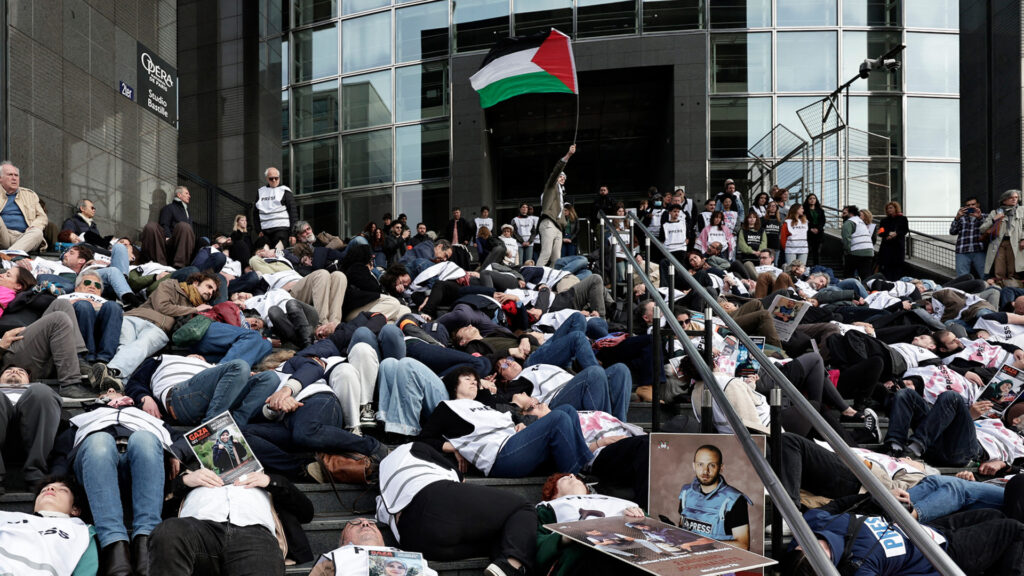
NewsFeed One hundred journalists staged a ‘die-in’ on the steps of the Opéra Bastille in central Paris to protest the killing of nearly 200 Palestinian journalists in Gaza since the war began. They laid on the steps in bloody press vests as the names of some of the journalists killed were read out. Published On 16 Apr 202516 Apr 2025 Adblock test (Why?)
Russia jails journalists for alleged ties to Navalny
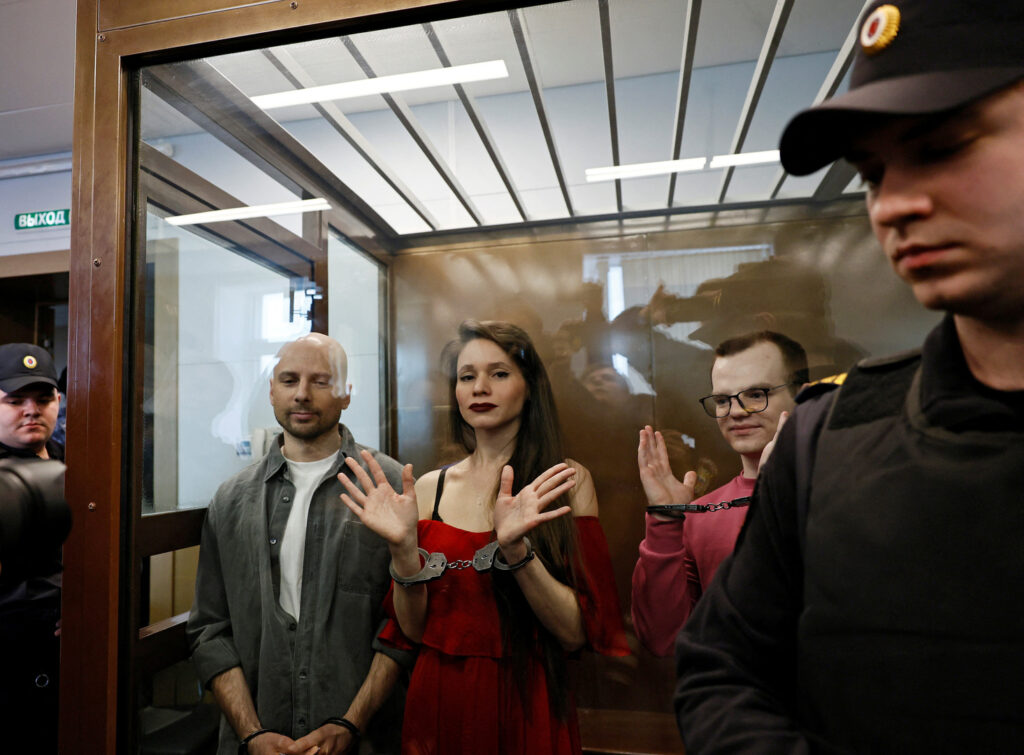
NewsFeed Four Russian journalists have been sentenced to over 5 years in prison for alleged ties to late opposition leader Alexey Navalny. All four reject the charges and supporters say they are being punished simply for doing their jobs. Published On 16 Apr 202516 Apr 2025 Adblock test (Why?)
